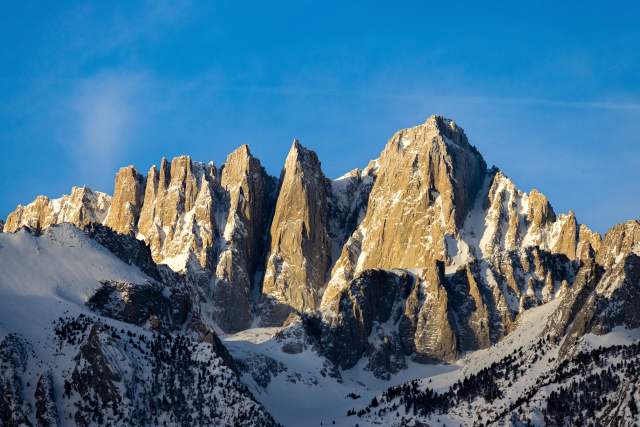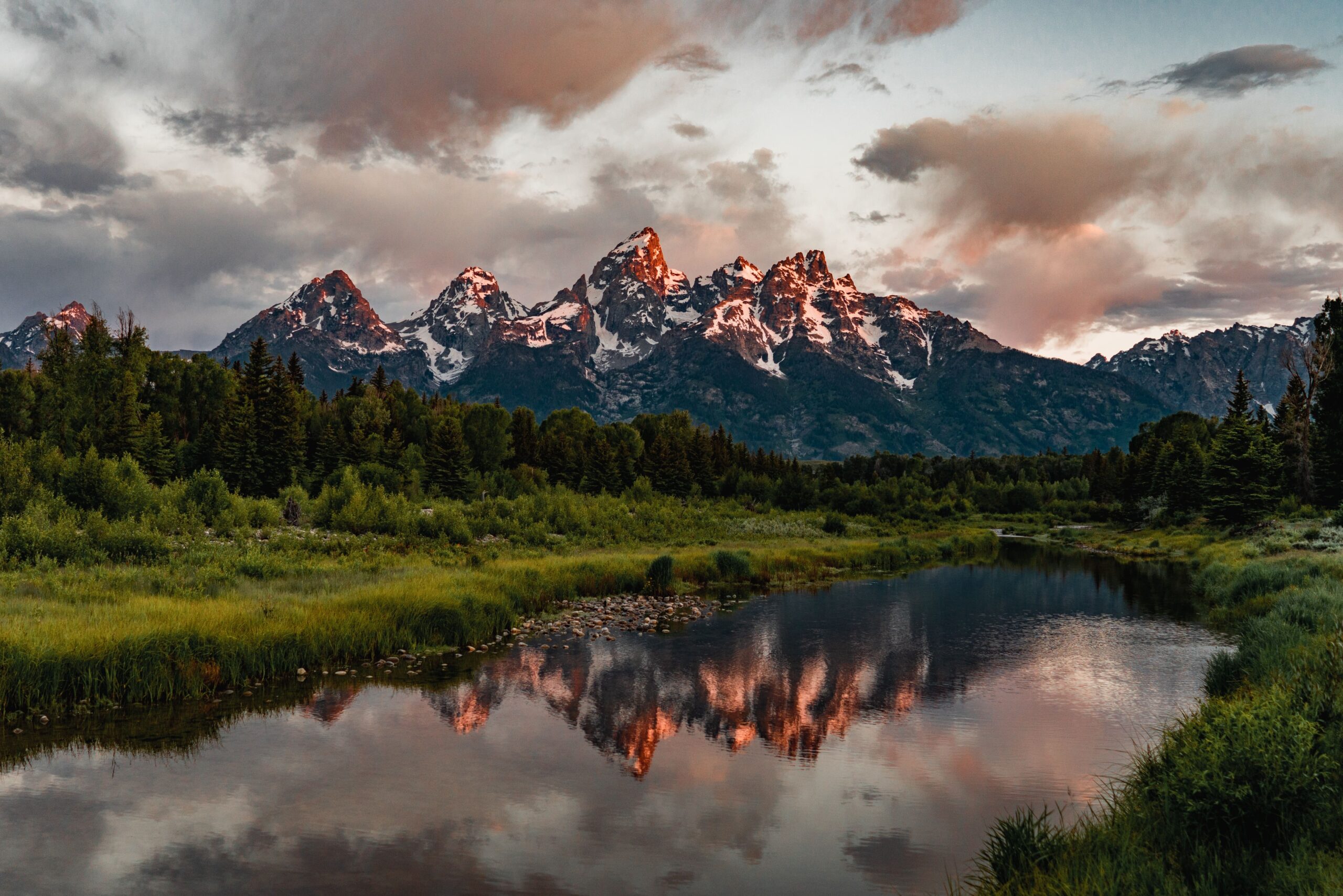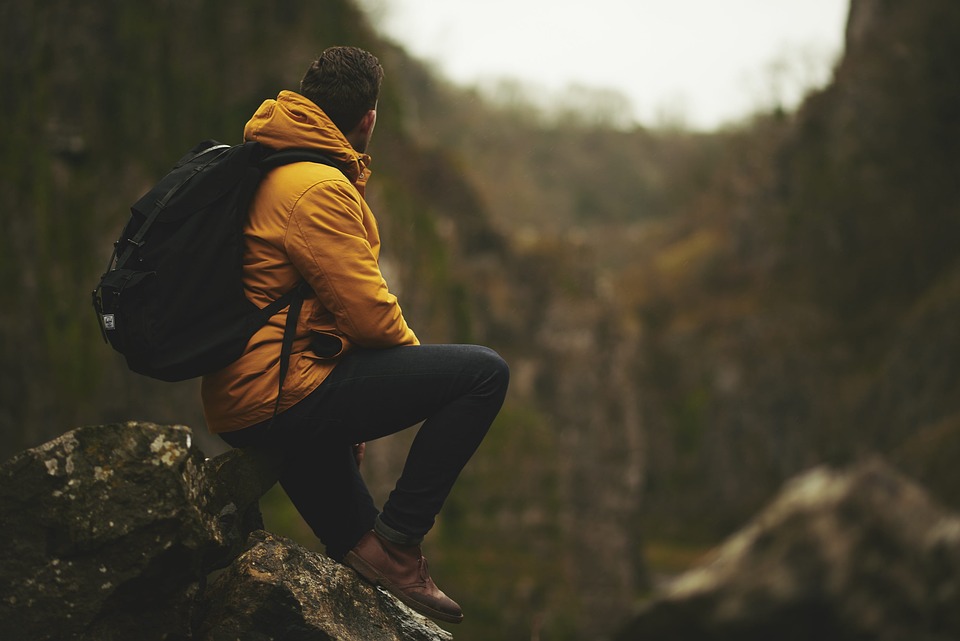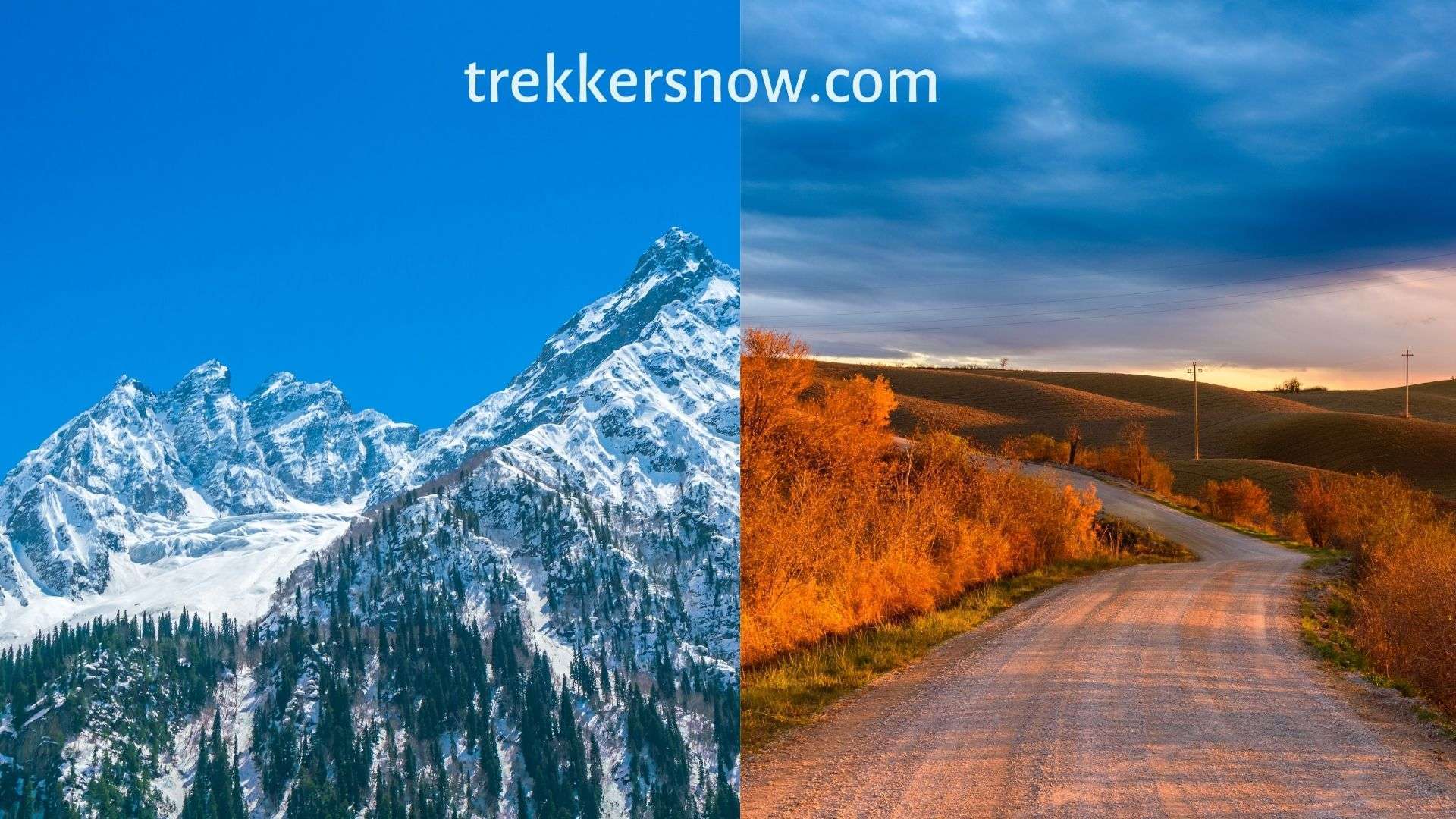Looking for a list of the Top 6 Mountains in the United States? These breathtaking peaks across the country are iconic features of its diverse landscapes.The spectacular views, difficult hiking trails, and possibilities for outdoor adventure are all provided by these high peaks. The United States is home to some of the most breathtaking mountains in the world, from the untamed Rockies to the snow-covered Sierras. This blog will cover the top 6 mountains in the United States, each showcasing its special beauty and attraction.
Where are the Top 6 highest mountains in us?

1. Mount Denali (Alaska): The Highest Mountain in the United States
Mount Denali, originally known as Mount McKinley, is the tallest mountain peak in North America and one of the most recognizable mountains in the world. This spectacular mountain, located in Alaska’s Denali National Park and Preserve, has long intrigued adventurers and explorers. Let’s explore the specifics of Mount Denali in depth.
Geographical Location: Mount Denali lies in the Alaska Range, a vast mountainous region in south-central Alaska. It lies about 130 miles (210 kilometers) northwest of Anchorage, Alaska’s largest city. The mountain’s coordinates are approximately 63.0695° N latitude and 151.0076° W longitude.
Elevation: At its summit, Mount Denali reaches an impressive elevation of 20,310 feet (6,190 meters) above sea level. People often refer to it as a ‘Fourteener,’ a term used for mountains with elevations exceeding 14,000 feet.
Name and Significance: Indigenous Athabascan name “Denali” (meaning “the high one”) was restored in 2015 after being named Mount McKinley.
First Ascent: First ascent of Mount Denali on June 7, 1913, led by Hudson Stuck and Harry Karstens.
Climbing Challenges: Mount Denali climbing: is challenging due to extreme elevation, harsh weather, and remote location. The mountain’s unpredictable weather can change rapidly, with blizzards, high winds, and extreme cold posing significant risks to climbers. As a result, only experienced mountaineers and well-prepared teams attempt the climb.
Wildlife and Conservation: Denali National Park: Vast wilderness, diverse wildlife, grizzlies, moose, wolves, caribou, Dall sheep. In 1917, they established the park to protect the unique ecosystems and wildlife of the region. Today, it remains a symbol of conservation efforts to preserve Alaska’s natural beauty and biodiversity.
Alaska’s Mount Denali: stunning, commanding peak with global allure due to beauty, culture, and challenging climbs.

2. Mount Rainier (Washington):
One of the most notable monuments in the Pacific Northwest of the United States is the iconic stratovolcano Mount Rainier, situated in the state of Washington. Mount Rainier earns the distinction of being the most glaciated mountain in the contiguous United States and also claims the title of the highest peak in Washington. The Cascade Range, a group of volcanic mountains stretching from northern California to southern British Columbia, Canada, includes Mount Rainier.
Geological Formation:
Mount Rainier, an active volcano, formed over millions of years through volcanic activity and glaciation. It belongs to the category of stratovolcanoes, also known as composite volcanoes, consisting of layers of hardened lava, volcanic ash, and other volcanic materials. Countless eruptions and glaciation events over the millennia have shaped the mountain’s current height and shape
Elevation and Prominence: Standing tall at 14,411 feet (4,392 meters) above sea level, Mount Rainier is the highest peak in the state of Washington. Its summit rises dramatically from its surroundings, with a prominence of approximately 13,210 feet (4,026 meters). The prominence of a mountain is a measure of how much it stands out from its base terrain and is a key factor in determining a mountain’s visual dominance in the landscape.
National Park Status: Mount Rainier’s natural beauty and geological significance led to the establishment of Mount Rainier National Park in 1899, making it the fifth national park in the United States. The park covers an area of over 236,000 acres (about 95,000 hectares) and encompasses diverse ecosystems, ranging from old-growth forests to subalpine meadows and high-elevation glaciers.
Glaciers and Snowfields: One of the defining features of Mount Rainier is its extensive glaciers and snowfields. The mountain is home to 26 major glaciers, the most notable being Emmons Glacier and Carbon Glacier, both of which are among the largest glaciers in the contiguous U.S. These glaciers not only contribute to the mountain’s picturesque appearance but also play a crucial role in shaping the landscape and providing water sources for surrounding regions.
Outdoor Recreation:
Mount Rainier National Park offers a wide range of recreational activities for visitors. Hiking is particularly popular, with numerous trails catering to all levels of hikers. The Wonderland Trail, a 93-mile (150 kilometers) loop that circumnavigates the mountain, provides an unforgettable backpacking experience. Climbers also flock to Mount Rainier to challenge themselves on its technical routes, although summit attempts require proper training and preparation.
Ecological Diversity: The park’s diverse ecosystems support a rich variety of flora and fauna. Lower elevations feature lush old-growth forests dominated by Douglas fir, western red cedar, and western hemlock. As the elevation increases, subalpine meadows burst into vibrant colors during the summer with an array of wildflowers. At higher elevations, hardy alpine plants and animals have adapted to survive in harsh conditions. Mount Rainier National Park dedicates itself to the preservation and protection of its natural resources through conservation efforts. Conservation efforts aim to safeguard the delicate balance between human recreation and the preservation of the park’s ecological integrity, ensuring that future generations can continue to appreciate the grandeur of this majestic mountain.
In conclusion, Mount Rainier is a stunning and recognizable mountain that serves as a representation of the natural splendor of the Pacific Northwest. With its huge glaciers, active volcanoes, and different ecosystems, it provides tourists with a rare chance to fully immerse themselves in the wonders of nature. For anybody who ventures into its majestic realm, Mount Rainier guarantees an amazing experience, whether they are looking for adventure on its difficult routes or simply want to soak up its inspiring presence.

3. Mount Whitney (California):
The tallest peak in the contiguous United States is Mount Whitney, which is in California. It is also one of the most popular hiking and mountaineering locations. Mount Whitney, a must-do adventure for outdoor enthusiasts, stands at 14,505 feet in the Sierra Nevada range, offering breathtaking height and a picturesque alpine setting. Let’s explore its location, features, hiking routes, permits, and crucial safety advice. It holds the title of the highest peak in the contiguous United States. The mountain’s characteristics include granite rock faces, snowy slopes, and a pristine alpine environment.
Hiking Routes: There are several popular routes to reach the summit of Mount Whitney, each offering a unique experience. The two primary hiking routes are:
Whitney Portal Trail: This is the most popular and well-established route to the summit. It begins at Whitney Portal, which is located at an elevation of approximately 8,360 feet (2,548 meters). The trail covers a distance of about 22 miles (35 kilometers) roundtrip and features an elevation gain of over 6,100 feet (1,860 meters). Hikers traverse through diverse landscapes, including lush forests, alpine meadows, and the iconic “Trail Crest,” which offers breathtaking views of the Sierra Nevada.
Mountaineer’s Route:
The Mountaineer’s Route is a more technical and challenging ascent that requires mountaineering skills and equipment. It starts at the North Fork of Lone Pine Creek and involves climbing steep slopes, rocky sections, and snow couloirs. Experienced climbers recommend this route and typically undertake it in the spring and early summer when snow conditions are favorable.
Permits and Regulations: For those who want to hike Mount Whitney, a permit system is in place to manage popularity and protect the wilderness. Both day hikes and overnight excursions need permits.
Many months in advance, a lottery system that most hikers use to get their permits opens. Additionally, those without reservations can purchase a limited quantity of walk-up permits at the Lone Pine Visitor Center. Planning and obtaining the required permits are essential for a safe and legal ascent.
Essential Tips for a Successful Climb:
Climbing Mount Whitney is a physically demanding and potentially hazardous undertaking. Here are some essential tips to ensure a successful and safe climb: Physical Preparedness: Train and prepare yourself physically for the rigors of the hike. It’s essential to be in good physical shape to handle the elevation gain and long distances. Acclimatization: Consider spending a day or two at higher elevations before attempting the summit to acclimate your body to the reduced oxygen levels.
Weather Awareness: Be aware of weather conditions and potential storms. Weather on the mountain can change rapidly, so always check the forecast before heading out.
Proper Gear: Bring adequate clothing, including warm layers, as temperatures can vary significantly. Don’t forget essentials like a hat, sunglasses, sunscreen, and sturdy hiking boots.
Water and Food: Carry enough water and high-energy snacks for the hike.
Plan accordingly as the trail has limited water sources.
Leave No Trace: Practice Leave No Trace principles to minimize your impact on the fragile alpine environment.
Climbing Mount Whitney is an unforgettable experience that rewards hikers with stunning vistas and a sense of accomplishment. However, approaching the climb with respect for the mountain’s challenges and being well-prepared for the journey ahead is essential. By following regulations, obtaining permits, and adhering to safety guidelines, you can make the most of your Mount Whitney adventure while preserving this natural wonder for generations to come.

4. Grand Teton (Wyoming):
Grand Teton is one of the most iconic and striking mountains in the United States, located in the state of Wyoming. It forms a part of the Teton Range, which is a subrange of the Rocky Mountains. Rising to an elevation of 13,776 feet (4,199 meters) above sea level, Grand Teton stands tall and proud in Grand Teton National Park, attracting millions of visitors each year with its rugged beauty and diverse recreational opportunities.
Geology and Formation: Teton Range formed through tectonic forces and glacial activity, Grand Teton’s steep, ancient crystalline rocks resist erosion.
Grand Teton National Park: Grand Teton National Park was established in 1929 and encompasses approximately 310,000 acres of breathtaking wilderness. The park’s centerpiece is the towering Grand Teton, but it also includes several other prominent peaks, pristine lakes, and abundant wildlife. The park offers a wide range of outdoor activities, making it a popular destination for hikers, climbers, anglers, and nature enthusiasts.
Hiking and Climbing:
Grand Teton National Park provides an array of hiking trails suitable for all skill levels. Some trails offer stunning views of the Grand Teton from a distance, while others lead to high alpine lakes or to the summit of the mountain itself. Climbing the Grand Teton is a coveted challenge for mountaineers, and multiple routes of varying difficulty are available, each requiring technical skills and proper preparation.
Wildlife and Biodiversity: With several species that live in this pristine ecology, the park is a shelter for animals. Among other famous creatures, tourists may see elk, bison, moose, black bears, and mule deer. Bald eagles and peregrine falcons are only two of the many bird species that can be seen by birdwatchers. Unmatched chances for animal observation and photography can be found in Grand Teton National Park.
Jackson Hole: The town of Jackson, located near the southern boundary of Grand Teton National Park, is often referred to as “Jackson Hole.” It serves as a gateway to the park and offers a vibrant atmosphere with its Western-style architecture, art galleries, and restaurants. Jackson is an excellent base for visitors to explore the park and enjoy the surrounding wilderness.
Preservation and Conservation:
Grand Teton National Park and the surrounding area are dedicated to conservation efforts to protect the natural beauty and wildlife habitat for future generations. The park’s protected status ensures that the breathtaking landscapes and diverse ecosystems will continue to thrive and be accessible for both enjoyment and scientific research.
To sum up, the Grand Teton in Wyoming is a magnificent and inspiring mountain that entices tourists from all over the world to explore its untamed nature, outdoor experiences, and breathtaking landscapes. Due to its importance in Grand Teton National Park, it serves as a beloved destination for nature enthusiasts, hikers, climbers, and anybody else looking to forge a stronger bond with the great outdoors.

5. Mount Elbert (Colorado):
Mount Elbert is the highest peak in the Rocky Mountains and the entire state of Colorado, making it one of the most prominent and sought-after mountains for hikers and climbers in the United States. Named after Samuel Hitt Elbert, the 15th governor of Colorado, this majestic peak offers breathtaking views, challenging trails, and a profound connection with nature. Here are the complete details about Mount Elbert:
Location: Mount Elbert is situated in the Sawatch Range of the Rocky Mountains, within the San Isabel National Forest in central Colorado. It is part of the Mount Elbert-Mount Massive Wilderness Area, known for its rugged beauty and pristine alpine environment.
Elevation:
Mount Elbert: Colorado’s highest point at 14,440 feet, among the famed “Fourteeners,” exceeding 14,000 feet.
Hiking and Climbing:
Mount Elbert attracts thousands of hikers and climbers each year due to its accessibility and non-technical ascent. The most popular route to the summit is the Northeast Ridge Trail, which starts at the North Mount Elbert Trailhead. The trail spans approximately 4.5 miles (7.2 kilometers) one-way and gains about 4,700 feet (1,432 meters) in elevation. While considered a strenuous hike, it does not require technical mountaineering skills, making it achievable for experienced hikers.
Scenic Beauty: As hikers ascend Mount Elbert, they are treated to awe-inspiring vistas of the surrounding Rocky Mountain landscape. The route offers breathtaking views of nearby peaks, alpine meadows, and glacial valleys. The summit provides a vast panorama of Colorado’s rugged terrain, allowing visitors to glimpse several other Fourteeners in the distance.
Weather and Safety: Despite its accessibility, climbers should not underestimate the challenges presented by Mount Elbert. The weather can be unpredictable, and conditions can change rapidly at high altitudes. It is essential to be prepared for sudden temperature drops, strong winds, and possible thunderstorms. Hikers dress in layers, carry ample water, and start early for a safe ascent and return.
Conservation: Mount Elbert and its surrounding wilderness area are protected by the U.S. Forest Service and the Bureau of Land Management to preserve the natural ecosystem and ensure sustainable recreation opportunities. Visitors should practice Leave No Trace principles, respecting the fragile alpine environment of Mount Elbert. Climbing offers a physical challenge and a chance to immerse in Colorado’s high country. Reaching the summit leaves a profound appreciation for the beauty of the Rockies.

6. Mount Katahdin (Maine):
Mount Katahdin lies in north-central Maine, part of the Appalachian Mountain range within Baxter State Park. The park encompasses over 200,000 acres of pristine wilderness, and Mount Katahdin serves as its crown jewel. The mountain’s rugged and rocky terrain contrasts sharply with the surrounding lush forests, creating a dramatic and captivating landscape. Mount Katahdin marks the Appalachian Trail’s endpoint, symbolizing a momentous achievement for thru-hikers dedication and perseverance.
Mount Katahdin offers diverse hiking trails for all experience levels and fitness.The most popular trails to the summit include
Hunt Trail: Traditional Appalachian Trail approach from Katahdin Stream Campground for thru-hikers.
Knife Edge Trail: Narrow, exposed ridge with breathtaking views for experienced hikers.
Saddle Trail: Day hikers prefer a less strenuous route from Chimney Pond over Hunt Trail.
Climbing and Wilderness Experience:
Climbing Mount Katahdin requires proper preparation and respect for the wilderness. The mountain’s weather can be unpredictable, with sudden changes in temperature and conditions, especially at higher elevations. Hikers and climbers need to equip themselves with appropriate clothing, sturdy footwear, and sufficient provisions.
Baxter State Park and Mount Katahdin offer diverse wildlife sightings. The summit provides awe-inspiring panoramic views of forests, lakes, and distant mountains.
Seasonal Considerations: Due to its northern location, Mount Katahdin experiences distinct seasons. The hiking season typically runs from late spring to early fall, with summer being the most popular time for visitors. Hikers should be aware of rapid weather changes and persistent snow at higher elevations until late spring and early summer.
Preservation and Conservation: Baxter State Park, including Mount Katahdin, dedicates itself to preserving its natural beauty and wilderness character. Encourage visitors to practice Leave No Trace principles, respect park rules, and minimize environmental impact.
Conclusion: Explore the “Top 6 Mountains in the US” for an unforgettable adventure amidst breathtaking panoramas. From the rugged Rockies to the serene Appalachians, these must-visit peaks cater to nature enthusiasts and thrill-seekers alike. Plan your journey, pack your gear, and immerse yourself in their splendor.



